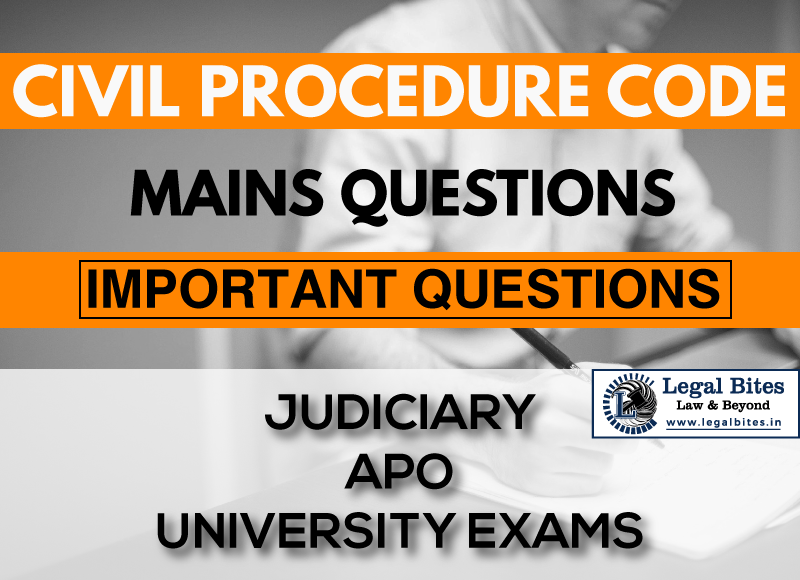What is an Interpleader Suit?
Find the answer to the mains question only on Legal Bites.

Question: What is an Interpleader Suit? [Bihar J 2014, UPCJ 1998, DJS 2007, JJS 2018] Find the answer only on Legal Bites. [What is an Interpleader Suit?] Answer An interpleader suit is a judicial proceeding that enables a person to compel parties making the same claim against him to litigate the matter between themselves. Interpleader suit in C.P.C is defined in section 88 with Order XXXV. Section 88 of the Civil Procedure Code, 1908 talks about what is an interpleader suit and when can...
Question: What is an Interpleader Suit? [Bihar J 2014, UPCJ 1998, DJS 2007, JJS 2018]
Find the answer only on Legal Bites. [What is an Interpleader Suit?]
Answer
An interpleader suit is a judicial proceeding that enables a person to compel parties making the same claim against him to litigate the matter between themselves. Interpleader suit in C.P.C is defined in section 88 with Order XXXV.
Section 88 of the Civil Procedure Code, 1908 talks about what is an interpleader suit and when can it be filed.
The provision states that: “Where two or more persons claim adversely to one another the same debts, sum of money or other property, movable or immovable, from another person, who claims no interest therein other than for charges or costs and who is ready to pay or deliver it to the rightful claimant such other person may institute a suit of interpleader against all the claimants for the purpose of obtaining a decision as to the person to whom the payment or delivery shall be made and of obtaining indemnity for himself:
Provided that where any suit is pending in which the rights of all parties can properly be decided, no such suit of interpleader shall be instituted.”
An interpleader suit within the meaning of this section is a suit in which the real dispute is between the defendants only and the defendants plead against each other instead of pleading against the plaintiff as is usually done in an ordinary suit. Thus, for example, A is in possession of a jewel box but he claims no interest in the box himself and is willing to hand it over to the rightful owner. The box is claimed by X and Y. A may file an interpleader suit against X and Y and the Court will decide as to who is the rightful owner of the box as between X and Y.
Who can institute an interpleader suit, and what is the procedure for it, reference may be made to Order XXXV of the C.P.C. Rule 4 of Order XXXV of the C.P.C. is as under:
(1) At the first hearing the court may—
-
- declare that the plaintiff is discharged from all liability to the defendants in respect of the thing claimed, award him his costs, and dismiss him from the suit; or
- if it thinks that justice or convenience so require, retain all parties until the final disposal of the suit.
(2) Where the court finds that the admissions of the parties or other evidence enable it to do so, it may adjudicate the title to the thing claimed.
(3) Where the admissions of the parties do not enable the court so to adjudicate, it may direct-
-
- that an issue or issues between the parties be framed and tried, and
- that any claimant is made a plaintiff in lieu of or in addition to the original plaintiff and shall proceed to try the suit in an ordinary manner.”
Under this rule, the court may decide the dispute, inter se, the defendants on the basis of admissions of the parties and if it is not possible to do so the court is empowered to frame the issues in the case arising between the defendants and make a claimant-defendant as the plaintiff in lieu of or in addition to the original plaintiff.
Important Mains Questions Series for Judiciary, APO & University Exams
- CPC Mains Questions Series: Important Questions Part – I of X
- CPC Mains Questions Series: Important Questions Part – II of X
- CPC Mains Questions Series: Important Questions Part – III of X
- CPC Mains Questions Series: Important Questions Part – IV of X
- CPC Mains Questions Series: Important Questions Part – V of X
- CPC Mains Questions Series: Important Questions Part – VI of X
- CPC Mains Questions Series: Important Questions Part – VII of X
- CPC Mains Questions Series: Important Questions Part – VIII of X
- CPC Mains Questions Series: Important Questions Part – IX of X
- CPC Mains Questions Series: Important Questions Part – X of X
Admin Legal Bites
Legal Bites Study Materials correspond to what is taught in law schools and what is tested in competitive exams. It pledges to offer a competitive advantage, prepare for tests, and save a lot of money.

